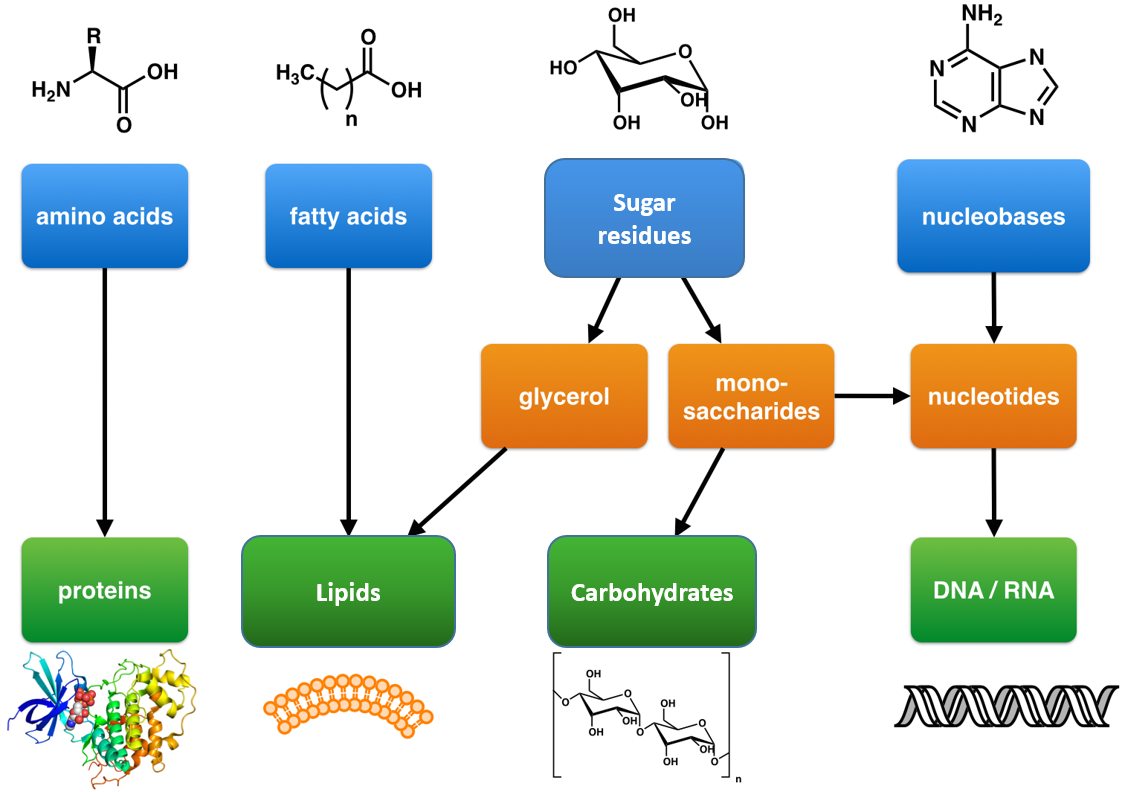Building larger organic molecules b. Formation of spheres or micells permits surface area and free energy reduction.

Ch105 Chapter 6 A Brief History Of Natural Products And Organic Chemistry Chemistry
The atoms of an organic molecule are typically organized around chains of carbon atoms.
. The atoms of an organic molecule are typically organized around chains of carbon atoms. Four of carbons six electrons are available to form bonds with other atoms. Had hypothesized that organic molecules could be created from inorganic molecules that could be found in the atmosphere of the young Earth.
Carbon is now known to form a seemingly unlimited number of compounds. Proteins lipids carbohydrates and nucleic acids. Early life on Earth.
First small organic molecules - such as amino acids which make proteins and nucleotides which make DNA - were made. Most of the carbon found in organic molecules originates from inorganic carbon. Second these small monomers combined to form larger and more complex polymers.
Inorganic compounds do not. They contain carbon but are considered inorganic because they do not contain hydrogen. In the 1920s Alexander Oparin and J.
Conformational analysis is an im-. Explain the connection between the beginning of life and the universal genetic code a. Ambiphilic molecules added to water tend to stay on the surface with hydrophilic heads in the water creating a single or mono- layer iea membrane.
Explain the RNA hypothesis can self replicate. The study of organic reactions. This is because of the variation in the amino acid which are the organic compounds that combine to form protein molecules.
Each of these four has their own unique chemical structure and their own specific function within living organisms. Noticeable exceptions are carbon monoxide CO carbon dioxide CO 2 carbonates eg. Carbon exhibits striking versatility in its ability to form various.
Different types of proteins have different biomolecules structures. Inorganic molecule form organic molecules b. Because these biomolecules are typically large we call them macromolecule s.
Scientists have developed several theories to explain how inorganic moleculesthe building blocks of lifejoined together to form living cells. Formation of organic molecules the building blocks of cells eg amino acids nucleotides simple sugars formation of. RNA are catalyst in module cells.
Inorganic compounds make up 115 of a living cells mass. Molecules of life met on clay. The uses of organic compounds impact our lives daily in medicine agriculture and general life.
Haldane independently proposed nearly identical hypotheses for how life originated on Earth. In this chapter we will review fundamental concepts of chemical structure and bonding in the organic molecules that make up drugs and their biological targets. Their hypothesis is now called the Oparin-Haldane hypothesis and the key steps are.
Organic molecules from comets 18. Functional groups combine with the chain to form biomolecules. There are 4 major biological macromolecules.
The origin of life on Earth began more. Organic chemistry is a branch of chemistry that studies the structure properties and reactions of organic compounds which contain carbon-carbon covalent bonds. Mulliken to describe the structure and properties of different molecules.
In theory Oparin 1923 organic chemistry may have its beginnings with the. Life came from space. Carbon chains form the skeletons of most organic molecules.
Organic molecules contain carbon. Inorganic compounds make up 115 of a living cells mass. In living systems large organic molecules called macromolecules can consist of hundreds or thousands of atoms.
In sufficient concentrations ambiphilic molecules will form a double-layer structure or bilayer. A string of peptides again forms unique peptide bonds. Many biologically relevant macromolecules are formed by linking together a great number of identical or very similar smaller organic molecules.
A detailed analysis of the various conformations adopted by individual molecules is termed Conformational Analysis. Pure carbon compounds such as diamond and. Conformations of Organic Molecules Conformational Analysis Organic molecules can assume different spatial arrangements conformations which are gener-ated by rotation about single bonds.
The Molecular Orbital Theory often abbreviated to MOT is a theory on chemical bonding developed at the beginning of the twentieth century by F. An organic molecule is one which contains carbon although not all compounds that contain carbon are organic molecules. The different types of peptides include polypeptide tripeptide and dipeptide.
They are small simple compounds that play important roles in the cell although they do not form cell structures. Study of structure determines their structural formulaStudy of properties includes physical and chemical properties and evaluation of chemical reactivity to understand their behavior. In biology abiogenesis or the origin of life is the natural process by which life has arisen from non-living matter such as simple organic compoundsThe prevailing scientific hypothesis is that the transition from non-living to living entities was not a single event but an evolutionary process of increasing complexity that involved the formation of a habitable planet the prebiotic.
Organic compounds are those that have carbon atoms. By organic we mean molecules that are constructed primarily from the element carbon C. The valence-bond theory failed to adequately explain how certain molecules contain two or more equivalent bonds.
Calcium carbide and cyanides eg. Formation of microspheres c. Calcium carbonate carbides eg.
Carbon oxides and carbonates are exceptions. However they were never able to duplicate the. Most macromolecules are polymers molecules that consist of a single unit monomer repeated many times.
Humans and other organisms are able to consume these macromolecules within the foods we eat every day as well as manufacture some of. Organic chemistry is the area of chemistry that involves the study of carbon and its compounds.

Organic Molecules Microbiology
D1 Origins Of Life On Earth Bioninja


0 Comments